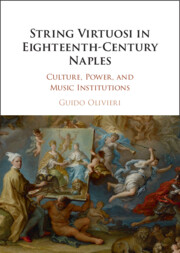Book contents
- String Virtuosi in Eighteenth-Century Naples
- String Virtuosi in Eighteenth-Century Naples
- Copyright page
- Dedication
- Contents
- Figures
- Tables
- Music Examples
- Acknowledgments
- Introduction
- 1 Music Institutions in Naples
- 2 The Formation of the Neapolitan String Virtuosi
- 3 Cello Virtuosi
- 4 Between Naples and Paris
- 5 Neapolitan Virtuosi in the Public Sphere
- 6 Neapolitan Instrumental Music under the Austrian Domination
- 7 Under the Wings of the Imperial Eagle
- Epilogue
- Bibliography
- Index
2 - The Formation of the Neapolitan String Virtuosi
Published online by Cambridge University Press: 13 January 2024
- String Virtuosi in Eighteenth-Century Naples
- String Virtuosi in Eighteenth-Century Naples
- Copyright page
- Dedication
- Contents
- Figures
- Tables
- Music Examples
- Acknowledgments
- Introduction
- 1 Music Institutions in Naples
- 2 The Formation of the Neapolitan String Virtuosi
- 3 Cello Virtuosi
- 4 Between Naples and Paris
- 5 Neapolitan Virtuosi in the Public Sphere
- 6 Neapolitan Instrumental Music under the Austrian Domination
- 7 Under the Wings of the Imperial Eagle
- Epilogue
- Bibliography
- Index
Summary
The chapter describes the central place of the four Neapolitan conservatories in the development of string pedagogy. New archival evidence and a reassessment of known documents allow the analysis of the financial and administrative structure of these educational institutions, the reconstruction of the artistic networks, and the admission process and daily teaching schedule of students. While the conservatories could guarantee a professional future to the children enrolled, the figlioli in turn constituted the main economic resource for these institutions. The pedagogical methods applied in these institutes were based on years of absolute dedication that exploited child labor. This systematic, if arduous, approach to music education played a crucial part in the professional training of the Neapolitan musicians and fostered the emergence of virtuosi whose fame became widespread in Europe. The details of the career of Giovanni Carlo Cailò, a Roman violinist who moved to Naples with Scarlatti and became the most influential string teacher in two of the four conservatories, explain the role and influence of a famed string maestro. A generation of eighteenth-century violin and cello virtuosi formed under Cailò contributed to disseminate the fame of the excellence of the string school established in the Neapolitan conservatories.
Keywords
- Type
- Chapter
- Information
- String Virtuosi in Eighteenth-Century NaplesCulture, Power, and Music Institutions, pp. 52 - 81Publisher: Cambridge University PressPrint publication year: 2023

